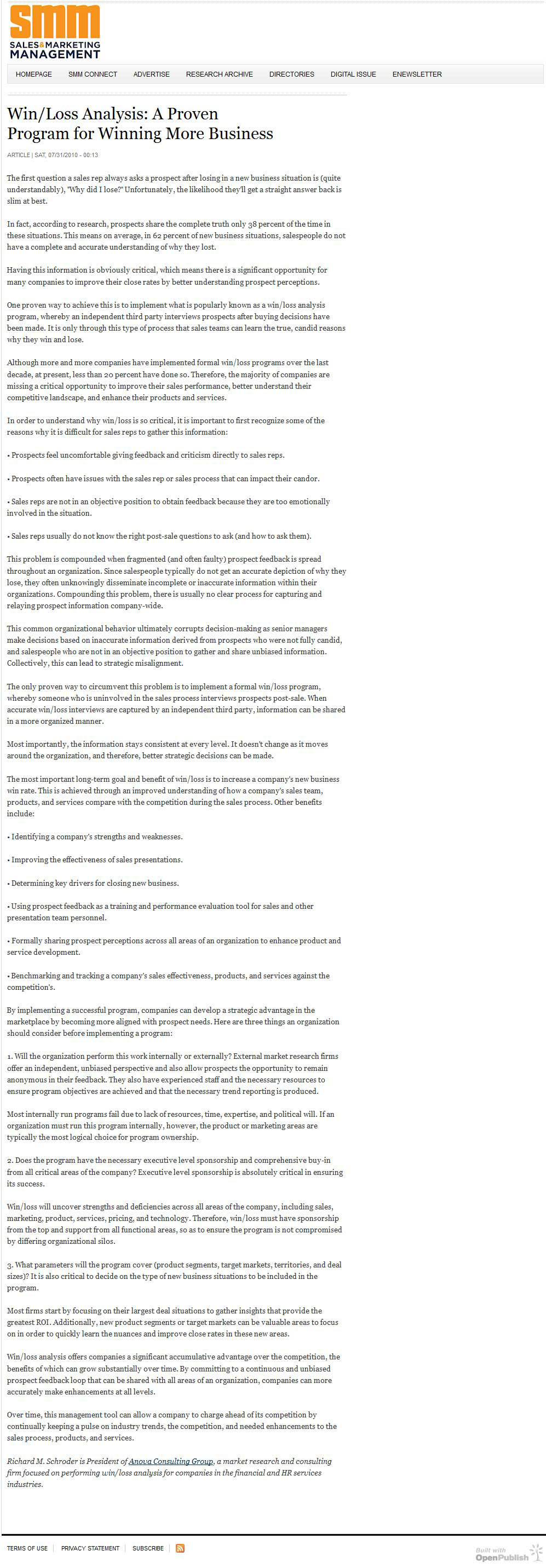


The first question a sales rep always asks a prospect after losing in a new business situation is (quite understandably), “Why did I lose?” Unfortunately, the likelihood they’ll get a straight answer back is slim at best.
In fact, according to research, prospects share the complete truth only 38 percent of the time in these situations. This means on average, in 62 percent of new business situations, salespeople do not have a complete and accurate understanding of why they lost.
Having this information is obviously critical, which means there is a significant opportunity for many companies to improve their close rates by better understanding prospect perceptions.
One proven way to achieve this is to implement what is popularly known as a Win / Loss analysis program, whereby an independent third party interviews prospects after buying decisions have been made. It is only through this type of process that sales teams can learn the true, candid reasons why they win and lose.
Although more and more companies have implemented formal programs over the last decade, at present, less than 20 percent have done so. Therefore, the majority of companies are missing a critical opportunity to improve their sales performance, better understand their competitive landscape, and enhance their products and services.
In order to understand why Win / Loss is so critical, it is important to first recognize some of the reasons why it is difficult for sales reps to gather this information:
• Prospects feel uncomfortable giving feedback and criticism directly to sales reps.
• Prospects often have issues with the sales rep or sales process that can impact their candor.
• Sales reps are not in an objective position to obtain feedback because they are too emotionally involved in the situation.
• Sales reps usually do not know the right post-sale questions to ask (and how to ask them).
This problem is compounded when fragmented (and often faulty) prospect feedback is spread throughout an organization. Since salespeople typically do not get an accurate depiction of why they lose, they often unknowingly disseminate incomplete or inaccurate information within their organizations. Compounding this problem, there is usually no clear process for capturing and relaying prospect information company-wide.
This common organizational behavior ultimately corrupts decision-making as senior managers make decisions based on inaccurate information derived from prospects who were not fully candid, and salespeople who are not in an objective position to gather and share unbiased information. Collectively, this can lead to strategic misalignment.
The only proven way to circumvent this problem is to implement a formal analysis program, whereby someone who is uninvolved in the sales process interviews prospects post-sale. When accurate interviews are captured by an independent third party, information can be shared in a more organized manner.
Most importantly, the information stays consistent at every level. It doesn’t change as it moves around the organization, and therefore, better strategic decisions can be made.
The most important long-term goal and benefit of Win / Loss is to increase a company’s new business win rate. This is achieved through an improved understanding of how a company’s sales team, products, and services compare with the competition during the sales process. Other benefits include:
• Identifying a company’s strengths and weaknesses.
• Improving the effectiveness of sales presentations.
• Determining key drivers for closing new business.
• Using prospect feedback as a training and performance evaluation tool for sales and other presentation team personnel.
• Formally sharing prospect perceptions across all areas of an organization to enhance product and service development.
• Benchmarking and tracking a company’s sales effectiveness, products, and services against the competition’s.
By implementing a successful program, companies can develop a strategic advantage in the marketplace by becoming more aligned with prospect needs. Here are three things an organization should consider before implementing a Win / Loss program:
1. Will the organization perform this work internally or externally? External market research firms offer an independent, unbiased perspective and also allow prospects the opportunity to remain anonymous in their feedback. They also have experienced staff and the necessary resources to ensure program objectives are achieved and that the necessary trend reporting is produced.
Most internally run programs fail due to lack of resources, time, expertise, and political will. If an organization must run this program internally, however, the product or marketing areas are typically the most logical choice for program ownership.
2. Does the Win / Loss program have the necessary executive level sponsorship and comprehensive buy-in from all critical areas of the company? Executive level sponsorship is absolutely critical in ensuring its success.
Win loss will uncover strengths and deficiencies across all areas of the company, including sales, marketing, product, services, pricing, and technology. Therefore, it must have sponsorship from the top and support from all functional areas, so as to ensure the program is not compromised by differing organizational silos.
3. What parameters will the program cover (product segments, target markets, territories, and deal sizes)? It is also critical to decide on the type of new business situations to be included in the program.
Most firms start by focusing on their largest deal situations to gather insights that provide the greatest ROI. Additionally, new product segments or target markets can be valuable areas to focus on in order to quickly learn the nuances and improve close rates in these new areas.
Win loss analysis offers companies a significant accumulative advantage over the competition, the benefits of which can grow substantially over time. By committing to a continuous and unbiased prospect feedback loop that can be shared with all areas of an organization, companies can more accurately make enhancements at all levels.
Over time, this management tool can allow a company to charge ahead of its competition by continually keeping a pulse on industry trends, the competition, and needed enhancements to the sales process, products, and services.